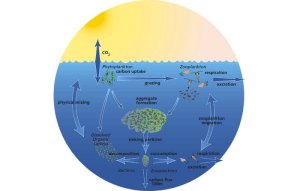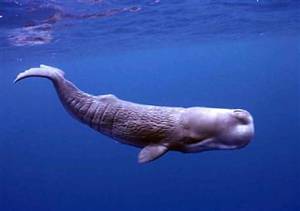Okay, so just a warning, the first half of this post is a mini-lesson on carbon in the ocean for those over achievers who just need to know. To get to the Sperm whale nitty gritty, jump to the section after the asterisks.
******************************************************************
So the name of the game with this climate change thing is carbon – the movement and interchange of carbon in and out of major reservoirs.
This ocean is massively important in the storage of this life sustaining element, and serves mostly as a sink for carbon (in terms of carbon, sinks are where it goes, and sources, where it comes from). It can hold roughly 50 times the amount normally held in the atmosphere.
There is however is robust carbon interplay between the ocean and the living things in it. All the living “stuff” in the ocean can be both sources of carbon (Respirers, like the creepy heavy breather on the other side of the phone line…) or can help move it along into deeper ocean depths where it tends to stay for an extended vacay. The movement of carbon to the ocean bottom is called the biological pump (note, I describe this in simplified terms. Carbon can take little forays off of this cycle – to see what a full cycle looks like, search for biological pump in google images).

Generally, plankton (oh yes, I know there is a definite possibility you are now picturing an ugly, one-eyed bad guy from the enthralling world of sponge-bob, but these are actually real, not just animated-real), the minuscule plants and animals in the ocean, drive the pump. Copepods, tiny planktonic crustaceans, release feacal pellets (read: poop) after eating that hopefully sink to the bottom. Also carbon can help increase plankton populations, and when plankton die (I wish I could insert a clip of taps that played right when you read this…), they sometimes sink to the bottom as detritus, moving alot of the carbon that was just hanging out in the surface down to the sea floor. Carbon in deep waters has a residence time of approximately 1000 years. For it to stay longer, it needs to actually be sequestered (fancy word for “buried”) in sediments, which happens to less than 1% of the carbon entering surface waters. (Note: it’s been suggested injecting carbon into the deep sea or sediments can solve our human carbon-emissions problem, but it comes at a price. See my post on ocean acidification, or my upcoming article on the subject that will be in the spring issue of the online Gulf of Maine Times.)
So, now you know…
And knowing is half the battle….
******************************************************************

According to this article – Sperm Whales as Carbon Sinks -, there were rumors going around that Sperm Whales were respiring out a large amount of carbon being introduced into the Southern Ocean. So they were essentially playing the role of carbon source rather than sink while oblivously swimming around and doing that whale thing they do. But as often happens, we’ve allegedly gotten better at the math, and now it appears they may be more helpful than deleterious in keeping the carbon where it’s supposed to be. When they dive into colder,more nutrient-rich waters to eat squid (See my blog entry on squid, it’s rockin) they bring some of the nutrients back with them which stimulates plankton growth. When the plankton die and sink (or release feacal pellets that sink), they’re setting the balance right and bringing carbon way down deep.
And the best part is these mammoth creatures glide about in their day to day lives, blissfully ignorant of their role in life, the universe, and everything.



